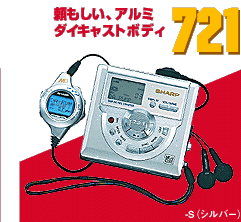

Joseph Reagle Jr.
December 1, 1998
I thought I would add a few comments on the Sharp MS721 as a complement to the numerous Sharp 701/702/722 reviews. [see MiniDisc Portable Recorder Product Table] The 721 is similar to the 722, however it lacks the jog dial and timer/alarm function. Prior to leaving for Japan, I had every intention of purchasing the 722. But after seeing and playing with both, I had to agree with Jake Eu's assessment that the 722 is ugly. Specifically, I was concerned about the raised plate becoming snagged or caught as I removed it from my courier case or pockets. However, I suspect that in use this is unlikely and my concern was mostly aesthetic. If you are into labeling your disks quickly (which I don't care about) or need yet another gadget beeping at you during your day (not me), the 722 will serve you better. In terms of heft, when comparing it at the counter, it is thicker/heavier than the Sony MS-R55. However, the MS721 began to feel lighter to me the more I used it, it fits quite comfortable in my coat pocket, front pants pocket, or bag. So while it is relatively heftier, in absolute terms, it's size is quite startling.
I bought my MS721 in Akibahara, Tokyo's famous Electric Town at "Duty Free." (There are many duty free signs, but there are a number of stores and stalls, all of which have the same owner, which go by First Duty Free, Second Duty Free, etc.). I paid 31,500 yen, or US$270! I received a discount and I was fortunate in that my sales person spoke a small amount of English which is not as likely on the street as it is in the larger stores such as Laox. While in Laox, I picked up some cables and a small microphone that plugged directly into the mic input of the recorder without a wire -- interestingly, at Laox, the MS721 was marked as a recommended purchase while the 722 was not.
I returned this microphone the next day because the mic was no more than half an inch from the MD unit itself and it picked up the occasional whirrings and buzzings of the head mechanism. This unit is not any louder than the other MD units I've seen, but it can be heard if one holds the unit up to one's ear or is within a couple feet of it within an absolutely silent room. I exchanged the first mic for a small, clip on mic with 3 feet of wire (Sony ECM717) that amazes me. Regardless, having had to consider the the occasional whirrings and buzzings I arrived at an insight as to why any unit would require a 40 second anti-shock memory and why energy consumption on these units has been dropping. That memory is not for anti-shock, rather, it seems that the MD unit reads and writes -- activities that consume most energy -- in rapid bursts. It makes little sense to have the head mechanism engaged continuously, when it can read/write data in a burst, idle, and serve the data out of a RAM buffer for the next 30 seconds. I suspect that MD technology will continue to have larger RAM buffers and may at some point converge with the static memory devices such as the RIO.
Regardless, to return to quality. One day in Harajuku I made a radio diary and interviewed folks on the street and the sound quality is great, it sounds professional, like on NPR! The notable thing about the extended battery life on these units is that I walked around for at least 4 hours, with a mic clipped on my chest, and the remote in my hand, hitting the resume (play when in record mode) button when there was a sound I thought interesting or a person I wished to speak to. On the hour train ride back to my friend's home, I edited about an hours worth of mildly interesting sound clips into a 15 minute sound journal entry of my day's adventure and played it for my friend's when I got back, all without ever having to recharge!
I wish the little record button actually lit up when it was recording, and I found the directions on the toggles on the remote to be a bit counterintuitive (I tend to think a tweak to the left as backwards, not forwards) but I've quickly adapted to its interface. Upon returning to the US, I've experimented with the dubbing capabilities. An analog dub has noticeable degradation -- but better than tape. The digital recordings sound perfect to my ears. The only thing I miss when listening at home is a remote control, and the fast forward or rewind mechanism is not as fast as those found on CD players.